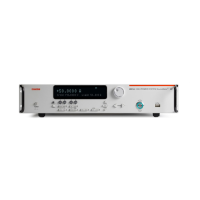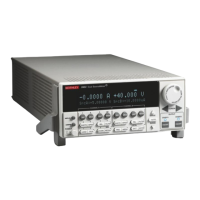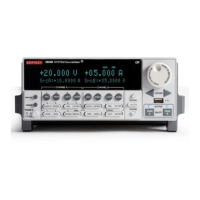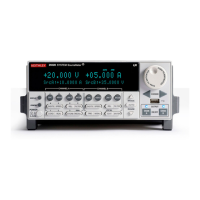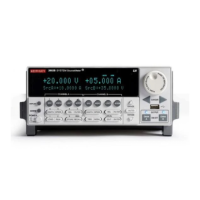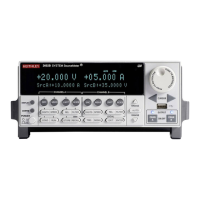Section 6: Instrument programming Model 2657A High Power System SourceMeter® Instrument Reference Manual
6-50 2657A-901-01 Rev. B/December 2012
TSP-Link system
You can use the TSP-Link
®
expansion interface to expand your test system to include up to 32
addressable TSP
®
enabled instruments that use the TSP-LINK
®
. The expanded system can be stand-
alone or computer-based.
Stand-alone system: You can run a script from the front panel of any instrument (node) connected
to the system. When a script is run, all nodes in the system go into remote operation (REM indicators
turn on). The node running the script becomes the master and can control all of the other nodes,
which become its subordinates. When the script is finished running, all the nodes in the system return
to local operation (REM indicators turn off), and the master/subordinate relationship between nodes is
dissolved.
Computer-based system: You can use a computer and a LAN, GPIB, or RS-232 interface to any
single node in the system. This node becomes the interface to the entire system. When a command
is sent through this node, all nodes go into remote operation (REM indicators turn on). The node that
receives the command becomes the master and can control all of the other nodes, which become its
subordinates. In a computer-based system, the master/subordinate relationship between nodes can
only be dissolved by performing an abort operation.
TSP-Link nodes
Each instrument (node) attached to the TSP-Link
®
network must be identified by assigning it a unique
TSP-Link node number.
Commands for remote nodes are stored in the node table. An individual node is accessed as
node[N], where N is the node number assigned to the node.
All TSP-accessible remote commands can be accessed as elements of the specific node. The
following attributes are examples of items you can access:
• node[N].model: The product model number string of the node.
• node[N].revision: The product revision string of the node.
• node[N].serialno: The product serial number string of the node.
You do not need to know the node number of the node that is running a script. The variable
localnode is an alias for the node entry of the node where the script is running. For example, if a
script is running on node 5, you can use the global variable localnode as an alias for node[5]. In
this example, to access the product model number, you would send:
print(localnode.model)
Connections
Connections for an expanded system are shown in the following figure. As shown, one instrument is
optionally connected to the computer using the GPIB, LAN, or RS-232 interface. Details about these
computer communication connections are described in Remote communication interfaces
(on page 2-
79).
All the instruments in the system are connected in a sequence (daisy-chained) using LAN crossover
cables.
